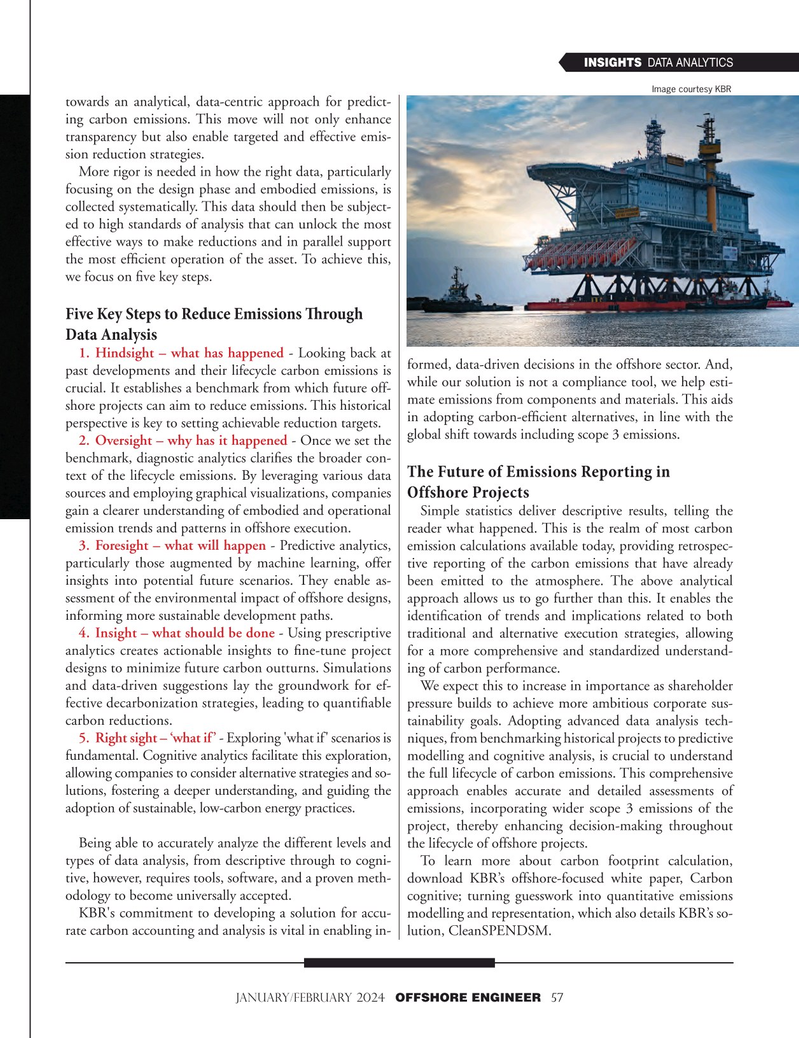
Page 57: of Offshore Engineer Magazine (Jan/Feb 2024)
Read this page in Pdf, Flash or Html5 edition of Jan/Feb 2024 Offshore Engineer Magazine
INSIGHTS DATA ANALYTICS
Image courtesy KBR towards an analytical, data-centric approach for predict- ing carbon emissions. This move will not only enhance transparency but also enable targeted and effective emis- sion reduction strategies.
More rigor is needed in how the right data, particularly focusing on the design phase and embodied emissions, is collected systematically. This data should then be subject- ed to high standards of analysis that can unlock the most effective ways to make reductions and in parallel support the most effcient operation of the asset. To achieve this, we focus on fve key steps.
Five Key Steps to Reduce Emissions Trough
Data Analysis 1. Hindsight – what has happened - Looking back at past developments and their lifecycle carbon emissions is formed, data-driven decisions in the offshore sector. And, while our solution is not a compliance tool, we help esti- crucial. It establishes a benchmark from which future off- shore projects can aim to reduce emissions. This historical mate emissions from components and materials. This aids in adopting carbon-effcient alternatives, in line with the perspective is key to setting achievable reduction targets.
2. Oversight – why has it happened - Once we set the global shift towards including scope 3 emissions.
benchmark, diagnostic analytics clarifes the broader con-
The Future of Emissions Reporting in text of the lifecycle emissions. By leveraging various data sources and employing graphical visualizations, companies
Offshore Projects gain a clearer understanding of embodied and operational Simple statistics deliver descriptive results, telling the emission trends and patterns in offshore execution. reader what happened. This is the realm of most carbon 3. Foresight – what will happen - Predictive analytics, emission calculations available today, providing retrospec- particularly those augmented by machine learning, offer tive reporting of the carbon emissions that have already insights into potential future scenarios. They enable as- been emitted to the atmosphere. The above analytical sessment of the environmental impact of offshore designs, approach allows us to go further than this. It enables the informing more sustainable development paths. identifcation of trends and implications related to both 4. Insight – what should be done - Using prescriptive traditional and alternative execution strategies, allowing analytics creates actionable insights to fne-tune project for a more comprehensive and standardized understand- designs to minimize future carbon outturns. Simulations ing of carbon performance.
and data-driven suggestions lay the groundwork for ef- We expect this to increase in importance as shareholder fective decarbonization strategies, leading to quantifable pressure builds to achieve more ambitious corporate sus- carbon reductions. tainability goals. Adopting advanced data analysis tech- 5. Right sight – ‘what if’ - Exploring 'what if' scenarios is niques, from benchmarking historical projects to predictive fundamental. Cognitive analytics facilitate this exploration, modelling and cognitive analysis, is crucial to understand allowing companies to consider alternative strategies and so- the full lifecycle of carbon emissions. This comprehensive lutions, fostering a deeper understanding, and guiding the approach enables accurate and detailed assessments of adoption of sustainable, low-carbon energy practices. emissions, incorporating wider scope 3 emissions of the project, thereby enhancing decision-making throughout
Being able to accurately analyze the different levels and the lifecycle of offshore projects.
types of data analysis, from descriptive through to cogni- To learn more about carbon footprint calculation, tive, however, requires tools, software, and a proven meth- download KBR’s offshore-focused white paper, Carbon odology to become universally accepted. cognitive; turning guesswork into quantitative emissions
KBR's commitment to developing a solution for accu- modelling and representation, which also details KBR’s so- rate carbon accounting and analysis is vital in enabling in- lution, CleanSPENDSM. january/february 2024 OFFSHORE ENGINEER 57

 56
56

 3rd Cover
3rd Cover